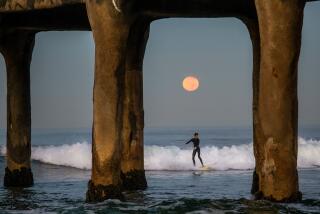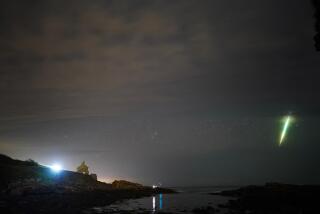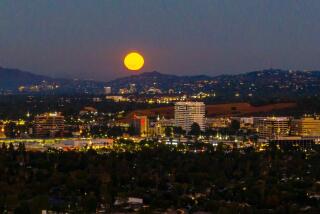Eclipse to Overshadow All Others This Century : Phenomenon: Total darkness will sweep from Hawaii to South America. Scientists, resorts prepare for the natural spectacle.
In one of the most spectacular shows that nature has to offer, the shadow of the moon will zip across the Pacific on July 11 during a total eclipse of the sun that will be like none other in this century.
The eclipse will turn day into night as the shadow speeds across the ocean, darkening the island of Hawaii and crossing over the southern tip of Baja California and continuing on down through Mexico, Central America and Brazil. More people will see it than any other eclipse in history.
“This is going to be an astronomical Woodstock,” said Leif Robinson, editor of Sky & Telescope magazine and a veteran of at least nine other total eclipses.
Prime viewing spots range from the lush Kona Coast of Hawaii to the tip of Baja, but the hotels in Hawaii have been booked for nearly a year, and Baja officials are expecting such a horde of visitors that they anticipate closing the highway leading to the southern resorts.
Orange County astronomers, who belong to what they say is the nation’s largest stargazing club, will be among those who make the trip.
John Sanford, past president of the Orange County Astronomers, said his group has already picked out a site in a pasture north of Cabo San Lucas in Baja California. The astronomers plan to set up equipment and canopies and other gear to accommodate many of the 380 people who are expected to make the trip south.
“This trip has been in the planning stages for at least two years,” said Sanford, who is acting as photo adviser to the eclipse group. “We’re going to be at what they call a ‘centerline.’ ” At that point, he said, the eclipse will occur almost directly overhead.
“We’re going to be getting it as long as you can get it, and as good as you can get it,” Sanford added.
With the prospect of an extraordinarily rare and lengthy eclipse, employees at one local astronomy shop said that they’ve already begun feeling the effects of the event.
“We’re seeing a lot of people who are planning to go to Baja or Hawaii,” said Joe Klotchman, a manager at Scope City, an astronomy instruments and accessories store in Costa Mesa. Sales are up, he said, and growing every day as the event gets closer.
“Most of the people are coming in and asking for solar filters,” which let telescope viewers train their instruments on the sun during an eclipse without burning their eyes, Klotchman said. “We already have a lot of the filters on back order.”
What sets this eclipse apart from most others is that it will last so long--in some regions, up to six minutes and 54 seconds of “totality,” when the moon will completely block out the sun--and it will pass over such densely populated regions that tens of millions of people should be able to see it.
It will also pass directly over the world’s leading astronomical observatory atop Mauna Kea on the island of Hawaii.
A total eclipse is far more than simply the shadow of the moon passing over the planet. It is the most spectacular show that the heavens provide.
The sky gradually darkens, and then the Earth plunges into a strange night. The temperature drops suddenly and nocturnal creatures emerge in response to the night-like conditions. The change in temperature frequently causes the winds to stir, wafting across a landscape that has been bathed first in twilight, and then darkness.
The stars will come out, but not in the familiar patterns of the summer sky. Instead, it will be the stars seen in the winter, which cannot normally be seen during the summer because they fill the sky during daylight hours.
Overhead, the dark disk of the moon will hide the sun, but a blazing rim of ethereal light, known as the sun’s corona, will surround the moon with a glow that can be seen only when the moon hides the brilliant light of the sun itself.
“In my opinion, an eclipse is the most spectacular of all natural phenomena,” said Harold Zirin, director of Caltech’s Big Bear Solar Observatory. “There’s just nothing else like it.”
That there should be such a thing as a total eclipse of the sun is nothing short of a celestial miracle.
The sun is 400 times larger than the moon, so how can it hide behind the moon? Because it is almost exactly 400 times farther away.
Thus the two bodies, so different in dimensions, appear as about the same size in the sky. If the moon was smaller, or farther away, a total eclipse would be impossible.
And most fortunately, the paths that the sun and moon follow across the sky cross each other, making it possible for the moon to pass directly between the Earth and the sun. Most of the time, the three bodies are not aligned correctly and the moon’s shadow misses the Earth entirely.
About a third of the time, the shadow crosses the Earth, but the moon does not completely cover the sun, resulting in a partial eclipse.
Since the moon varies in its distance from the Earth, some of the time it is not quite big enough to cover the entire sun, resulting in an “annular” eclipse in which only the center of the sun is blocked out. Such an eclipse will pass over Los Angeles in 1992.
But every now and then, everything matches up perfectly, producing a lunar shadow that moves swiftly across the Earth. The shadow sweeps across a path so narrow that any one place on the surface of the Earth experiences a total eclipse only once every 360 years. London, for example, has not had a total eclipse since 1715.
Astronomers have long cherished these events because they present the best chance to study the sun’s corona. Fierce solar storms that blast pillars of fire out from the sun’s surface stand out brilliantly around the dark disk of the moon.
Eclipses also permitted scientists to confirm one of the most basic concepts in Albert Einstein’s theory of relativity.
The great scientist had concluded that even light is influenced by gravity. During a total eclipse in 1919, scientists proved Einstein was right when they were able to observe some stars that were actually behind the darkened sun. The sun’s field of gravity bent the rays of light emitted by the stars, thus making it possible to see stars that should have been hidden.
The observations turned Einstein into an international celebrity.
Modern scientific instruments, on Earth as well as in space, have permitted scientists to study the sun without the aid of an eclipse.
But this eclipse is extraordinary in that it will pass directly over the observatories on Mauna Kea. Zirin plans to use a Caltech telescope on Mauna Kea to measure temperature changes in the sun’s atmosphere, called the solar chromosphere. As the moon moves across the sun, it will “slice off” pieces of the chromosphere, permitting Zirin to get “really accurate measurements of the temperature gradient,” he said.
He said he does not expect any surprises, and he’s not sure he wants any.
“Suppose we discovered something exciting,” he said. “It will be 100 years before another eclipse passes over an observatory” and the discovery can be confirmed.
Although total eclipses occur fairly frequently, they tend to pass over uninhabited areas such as the north Atlantic or north Pacific oceans. Scientists and eclipse aficionados have been known to journey as far away as Finland to view a total eclipse that lasted only a few seconds.
According to meteorologist Joe Rao, who has written a book about the upcoming eclipse, the best viewing will be from the top of Mauna Kea on the Big Island of Hawaii, but access to that astronomical outpost will be restricted to scientists, journalists and others who can prove a need to be there.
For others, Rao believes that the best site is the southern tip of Baja. But so many people are expected to head there that Baja officials, concerned about the region’s ability to support such a sudden rise in population, are expected to close the highway.
“We keep hearing that the federales will close the road,” said Sanford of the Orange County group. Although a few of the local participants are planning to drive, many will go down several days before the eclipse and spend the whole week, he added.
Sky & Telescope’s Robinson, who will lead an expedition of 1,000 people to Baja, estimated that about 150,000 people will go to Baja for the eclipse.
Rodolfo Palacios Romo, who is in charge of coordinating eclipse activities for the government of Baja California, has already issued a warning.
“If you don’t have a place to stay, don’t come,” he said recently. Hotels from La Paz to Cabo San Lucas are booked, and camping on beaches and public lands will not be allowed without special permission, he said.
Rivaling Baja for viewing conditions will be the west coast of the island of Hawaii.
“Most of the hotels have been sold out for a long time,” said Leslie Anderson of the newly opened Ritz-Carlton.
The Big Island is the only island in the Hawaiian chain where the eclipse will be total.
The duration of the eclipse will vary widely because the length depends on the size of the shadow and the speed at which it moves across the Earth. The eclipse will begin at sunrise roughly 1,200 miles west-southwest of Hawaii. The total phase of the eclipse will hit the Big Island at 7:30 a.m. local time. The “path of totality” will cross Baja a little before noon, and then pass over Mexico before turning southeast to cross Central America, Colombia and Brazil around sunset.
Because of the curvature of the Earth, the dark shadow of the moon during a total eclipse--called the “umbra”--is elliptical, not circular. When it reaches Hawaii it will measure 139 miles wide by 388 miles long, giving a total eclipse of up to 4 minutes, 10 seconds. The sun will be 22 degrees above the horizon.
In the beginning, the shadow will move across the Earth at 16,000 miles an hour, but it will slow as the sun moves overhead. By the time it reaches Baja, the umbra will be traveling 1,450 miles an hour. The duration of the total eclipse at Baja will be 6 minutes, 28 seconds, close to the maximum possible duration for any eclipse--7 minutes and 40 seconds. The sun will be almost directly overhead.
Los Angeles will see a partial eclipse during which up to 74% of the sun will be obscured.
That is not enough to create much of a sensation, according to John Mosley, program supervisor at Griffith Observatory.
“If you are just walking around, you may not notice it,” Mosley said.
Mosley said the observatory has been getting inquiries about the eclipse since last summer, and the planetarium there features a program on the eclipse. It will run through July 14.
The eclipse must be viewed through lenses that protect the eyes. Viewing it with sunglasses could cause severe damage. Protective viewing cards are available at the Griffith Observatory.
According to ancient mythology, an eclipse occurred whenever a great beast was devouring the sun.
The earliest astronomers believed they could end the ordeal by beating upon pots and pans to scare off the beast, so whenever an eclipse occurred, it was a noisy as well as a visual event. Wise men beat upon their noisemakers to chase away the beast and restore the sun to its brilliant glory.
It worked every time.
More to Read
Sign up for The Wild
We’ll help you find the best places to hike, bike and run, as well as the perfect silent spots for meditation and yoga.
You may occasionally receive promotional content from the Los Angeles Times.






